《简明语言学教程》 课件第五章 语义学
- 格式:ppt
- 大小:4.18 MB
- 文档页数:97

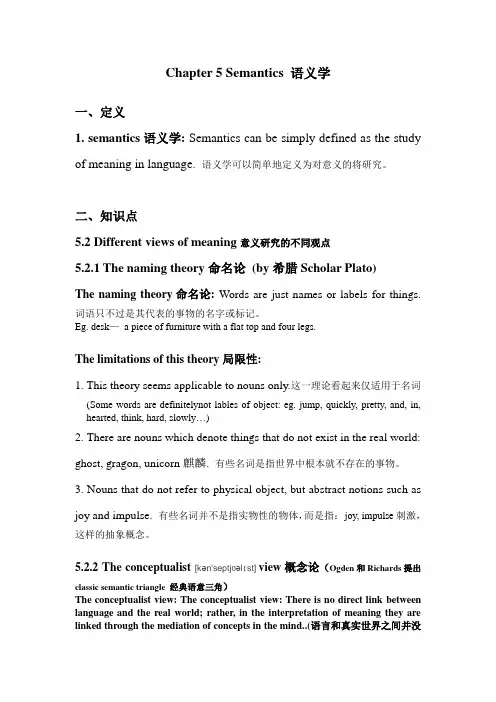
Chapter 5 Semantics 语义学一、定义1. semantics语义学: Semantics can be simply defined as the study of meaning in language. 语义学可以简单地定义为对意义的将研究。
二、知识点5.2 Different views of meaning意义研究的不同观点5.2.1 The naming theory命名论(by希腊Scholar Plato)The naming theory命名论: Words are just names or labels for things.词语只不过是其代表的事物的名字或标记。
Eg. desk—a piece of furniture with a flat top and four legs.The limitations of this theory局限性:1. This theory seems applicable to nouns only.这一理论看起来仅适用于名词(Some words are definitelynot lables of object: eg. jump, quickly, pretty, and, in, hearted, think, hard, slowly…)2. There are nouns which denote things that do not exist in the real world: ghost, gragon, unicorn麒麟. 有些名词是指世界中根本就不存在的事物。
3. Nouns that do not refer to physical object, but abstract notions such as joy and impulse. 有些名词并不是指实物性的物体,而是指:joy, impulse刺激,这样的抽象概念。

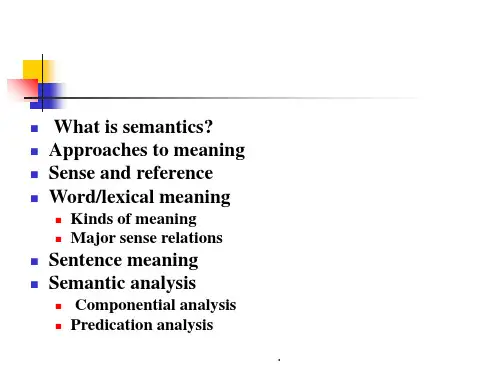
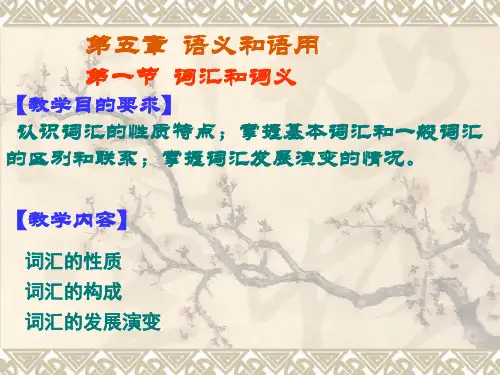
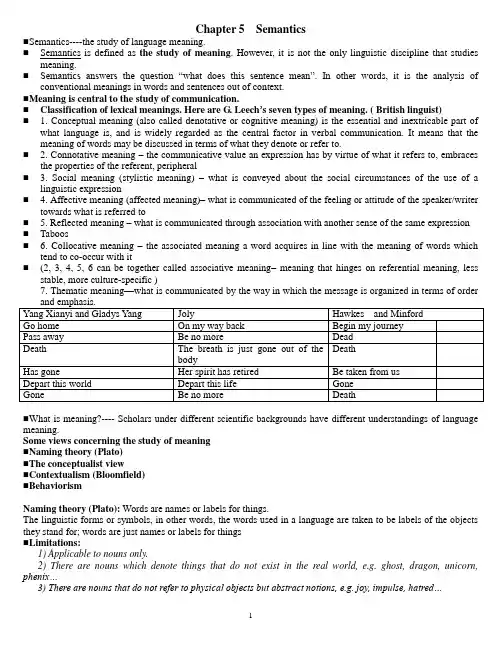
Chapter 5 Semantics⏹Semantics----the study of language meaning.⏹Semantics is defined as the study of meaning. However, it is not the only linguistic discipline that studiesmeaning.⏹Semantics answers the question “what does this sentence mean”. In other w ords, it is the analysis ofconventional meanings in words and sentences out of context.⏹Meaning is central to the study of communication.⏹Classification of lexical meanings. Here are G. Leech’s seven types of meaning. ( British linguist)⏹ 1. Conceptual meaning (also called denotative or cognitive meaning) is the essential and inextricable part ofwhat language is, and is widely regarded as the central factor in verbal communication. It means that the meaning of words may be discussed in terms of what they denote or refer to.⏹ 2. Connotative meaning – the communicative value an expression has by virtue of what it refers to, embracesthe properties of the referent, peripheral⏹ 3. Social meaning (stylistic meaning) –what is conveyed about the social circumstances of the use of alinguistic expression⏹ 4. Affective meaning (affected meaning)– what is communicated of the feeling or attitude of the speaker/writertowards what is referred to⏹ 5. Reflected meaning – what is communicated through association with another sense of the same expression ⏹Taboos⏹ 6. Collocative meaning – the associated meaning a word acquires in line with the meaning of words whichtend to co-occur with it⏹(2, 3, 4, 5, 6 can be together called associative meaning–meaning that hinges on referential meaning, lessstable, more culture-specific )7. Thematic meaning—what is communicated by the way in which the message is organized in terms of order⏹What is meaning?---- Scholars under different scientific backgrounds have different understandings of language meaning.Some views concerning the study of meaning⏹Naming theory (Plato)⏹The conceptualist view⏹Contextualism (Bloomfield)⏹BehaviorismNaming theory (Plato): Words are names or labels for things.The linguistic forms or symbols, in other words, the words used in a language are taken to be labels of the objects they stand for; words are just names or labels for things⏹Limitations:1) Applicable to nouns only.2) There are nouns which denote things that do not exist in the real world, e.g. ghost, dragon, unicorn, phenix…3) There are nouns that do not refer to physical objects but abstract notions, e.g. joy, impulse, hatred…The conceptualist view⏹The conceptualist view holds that there is no direct link between a linguistic form and what it refers to (i.e. between language and the real world); rather, in the interpretation of meaning they are linked through the mediation of concepts in the mind.⏹⏹The referent refers to the object in the world of experience;⏹Thought or reference refers to concept.⏹The symbol or a word signifies things by virtue of the concept associated with the form of the word in the minds of the speaker; and the concept looked at from this point of view is the meaning of the word.⏹Meaning should be studied in terms of situation, use, context—elements closely linked with language behavior. Two types of contexts are recognized:⏹Situational context: spatiotemporal situation⏹Linguistic context: the probability of a word’s c o-occurrence or collocation.⏹For example, “black” in black hair& black coffee,or black sheep differs in meaning; “The president of the United States” can mean either the president or presidency in different situation.calls forth in the hearer⏹Behaviorists attempted to define meaning as “the situation in which the speaker utters it and the response it calls forth in the hearer”.⏹The story of Jack and Jill:Jill JackS_________r--------s_________RLexical meaning⏹Sense and reference are both concerned with the study of word meaning. They are two related but different aspects of meaning.⏹Sense---- is concerned with the inherent meaning of the linguistic form. It is the collection of all the features of the linguistic form; it is abstract and de-contextualized. It is the aspect of meaning dictionary compilers are interested in.⏹Reference----what a linguistic form refers to in the real, physical world; it deals with the relationship between thelinguistic element and the non-linguistic world of experience.⏹Linguistic expressions stand in a relation to the world. There are two aspects of meaning.⏹Reference is the relation by which a word picks out or identifies an entity in the world. But the referentialtheory fails to account for certain kinds of linguistic expression.⏹Some words are meaningful, but they identify no entities in the real world, such as the words dragon, phoenix,unicorn, and mermaid.⏹It is not possible for some words to find referent in the world, such as the words but, and, of, however, the, etc.⏹Speakers of English understand the meaning of a round triangle although there is no such graph.⏹Sense is the relation by which words stand in human mind. It is mental representation, the association withsomething in t he speaker’s or hearer’s mind. The study of meaning from the perspective of sense is called the representational approach.Note:⏹Linguistic forms having the same sense may have different references in different situations; on the other hand, there are also occasions, when linguistic forms with the same reference might differ in sense, e.g. the morning star and the evening star, rising sun in the morning and the sunset at dusk.Major sense relations⏹Synonymy, Antonymy, Polysemy, Homonymy, HyponymySynonymy⏹Synonymy refers to the sameness or close similarity of meaning. Words that are close in meaning are called synonyms.1) Dialectal synonyms---- synonyms used in different regional dialects, e.g. autumn - fall, biscuit - cracker, petrol –gasoline,lift/elevator, flat/apartment…2) Stylistic synonyms----synonyms differing in style, e.g. kid, child, offspring; start, begin, commence; gentleman/guy…3) Synonyms that differ in their emotive or evaluative meaning, e.g.collaborator- accomplice, attract/seduce4) Collocational synonyms, e.g. accuse…of, charge…with, rebuke…for; …5) Semantically different synonyms, e.g. amaze, astound,…◆Synonyms are frequently used in speaking and writing as a cohesive device. In order to avoidrepetition the writer/speaker needs to use a synonym to replace a word in the previous co-text whenhe/she wants to continue to address that idea. The synonyms together function to create cohesion ofthe text.Antonymy◆Antonyms are words which are opposite in meaning.⏹Gradable antonyms----there are often intermediate forms between the two members of a pair, e.g. old-young, hot-cold, tall-short, …⏹Complementary antonyms----the denial of one member of the pair implies the assertion of the other, e.g. alive-dead, male-female, …⏹Relational/ Reversal opposites----exhibits the reversal of the relationship between the two items, e.g. husband-wife, father-son, doctor-patient, buy-sell, let-rent, employer-employee, give-receive, above-below, … Gradable antonyms⏹Gradable antonyms ----there are often intermediate forms between the two members of a pair, e.g. old-young, hot-cold, tall-short, …Complementary antonyms⏹Complementary antonyms ----the denial of one member of the pair implies the assertion of the other, e.g. alive-dead, male-female, …⏹Antonymy is frequently utilized as a rhetorical resource in language use. Oxymoron and antithesis based onantonymy. Gradable antonyms may give rise to fuzziness.Polysemy⏹Polysemy----the same one word may have more than one meaning, e.g. “table” may mean:⏹A piece of furniture⏹All the people seated at a table⏹The food that is put on a table⏹A thin flat piece of stone, metal wood, etc.⏹Orderly arrangement of facts, figures, etc.Homonymy⏹Homonymy---- the phenomenon that words having different meanings have the same form, e.g. different words are identical in sound or spelling, or in both.⏹Homophone ---- when two words are identical in sound, e.g. rain-reign, night/knight, …⏹Homogragh ---- when two words are identical in spelling, e.g. tear(n.)-tear(v.), lead(n.)-lead(v.), …⏹Complete/full homonym---- when two words are identical in both sound and spelling, e.g. ball, bank, watch, scale, fast, …⏹Note: Rhetorically, homonyms are often used as puns.⏹A polysemic word is the result of the evolution of the primary meaning of the word (the etymology of the word); while complete homonyms are often brought into being by coincidence.Hyponymy⏹Hyponymy----the sense relation between a more general, more inclusive word and a more specific word.⏹Superordinate: the word which is more general in meaning.⏹Hyponyms: the word which is more specific in meaning.⏹Co-hyponyms: hyponyms of the same superordinate.Hyponymy⏹Superordinate: flower⏹Hyponyms: rose, tulip, li ly, chrysanthemum, peony, narcissus, …⏹Superordinate: furniture⏹Hyponyms: bed, table, desk, dresser, wardrobe, sofa, …⏹This kind of vertical semantic relation links words in a hierarchical work.Sense relations between sentences⏹(1) X is synonymous with Y⏹(2) X is inconsistent with Y⏹(3) X entails Y⏹(4) X presupposes Y⏹(5) X is a contradiction⏹(6) X is semantically anomalousX is synonymous with Y⏹X: He was a bachelor all his life.Y: He never got married all his life.⏹X: The boy killed the cat.Y: The cat was killed by the boy.⏹If X is true, Y is true; if X is false, Y is false.X is inconsistent with Y⏹X: He is single.⏹Y: He has a wife.⏹X: This is my first visit to Beijing.⏹Y: I have been to Beijing twice.⏹If X is true, Y is false; if X is false, Y is true.X entails Y⏹X: John married a blond heiress.⏹Y: John married a blond.⏹X: Marry has been to Beijing.⏹Y: Marry has been to China.⏹Entailment is a relation of inclusion. If X entails Y, then the meaning of X is included in Y.⏹If X is true, Y is necessarily true; if X is false, Y may be true or false.X presupposes Y⏹X: His bike needs repairing.⏹Y: He has a bike.⏹Paul has given up smoking.⏹Paul once smoked.⏹If X is true, Y must be true; If X is false, Y is still true.X is a contradiction⏹*My unmarried sister is married to a bachelor.⏹*The orphan’s parents are pretty well-off.X is semantically anomalous⏹*The man is pregnant.⏹*The table has bad intentions.⏹*Sincerity shakes hands with the black apple.⏹Analysis of meaning :⏹Componential analysis⏹Predication analysis⏹Componential analysis⏹Componential analysis---- a way to analyze lexical meaning. The approach is based on the belief that the meaning of a word can be dissected into meaning components, called semantic features. For example,⏹Man: [+HUMAN, +ADULT, +ANIMATE, +MALE]⏹Boy: [+HUMAN, -ADULT, +ANIMATE, +MALE]⏹Woman: [+HUMAN, +ADULT, +ANIMATE, -MALE]⏹Girl: [+HUMAN, -ADULT, +ANIMATE, -MALE]⏹Father: +HUMAN +MALE +ADULT →PARENT⏹Daughter: +HUMAN –MALE 0ADULT ←PARENTPredication analysis⏹1) The meaning of a sentence is not to be worked out by adding up all the meanings of its component words, e.g “The dog bites the man”is semantically different from “The man bites the dog” though their components are exactly the same.⏹2) There are two aspects to sentence meaning: grammatical meaning and semantic meaning, e.g.⏹*Green clouds are sleeping furiously.⏹*Sincerity shook hands with the black apple.⏹Whether a sentence is semantically meaningful is governed by rules called selectional restrictions.⏹Predication analysis---- a way to analyze sentence meaning (British G. Leech).⏹Predication----the abstraction of the meaning of a sentence. A predication consists of argument(s) and predicate.⏹An argument is a logical participant in a predication, largely identical with the nominal elements in a sentence. ⏹A predicate is something said about an argument or it states the logical relation linking the arguments in a sentence.⏹According to the number of arguments contained in a predication, we may classify the predications into the following types:⏹One-place predication: smoke, grow, rise, run, …⏹Two-place predication: like, love, save, bite, beat,…⏹Three-place predication: give, sent, promise, call, …⏹No-place predication: It is hot.Predication analysis⏹Tom smokes.→ TOM (SMOKE)⏹The tree grows well.→ TREE (GROW)⏹The kids like apples.→ KIDS (LIKE) APPLE⏹I sent him a letter.→ I (SEND) HIM LETTERSupplementary Exercises to Chapter 5 SemanticsI. Decide whether each of the following statements is True or False:1. Dialectal synonyms can often be found in different regional dialects such as British English and American English but cannot be found within the variety itself, for example, within British English or American English.2. Sense is concerned with the relationship between the linguistic element and the non-linguistic world of experience, while the reference deals with the inherent meaning of the linguistic form.3. Linguistic forms having the same sense may have different references in different situations.4. In semantics, meaning of language is considered as the intrinsic and inherent relation to the physical world of experience.5. Contextualism is based on the presumption that one can derive meaning from or reduce meaning to observable contexts.6. Behaviourists attempted to define the meaning of a language form as the situation in which the speaker utters it and the response it calls forth in the hearer.7. The meaning of a sentence is the sum total of the meanings of all its components.8. Most languages have sets of lexical items similar in meaning but ranked differently according to their degree of formality.9. “it is hot.” is a no-place predication because it contains no argument.10. In grammatical analysis, the sentence is taken to be the basic unit, but in semantic analysis of a sentence, the basic unit is predication, which is the abstraction of the meaning of a sentence.II. Fill in each of the following blanks with one word which begins with the letter given:11. S________ can be defined as the study of meaning.12. The conceptualist view holds that there is no d______ link between a linguistic form and what it refers to.13. R______ means what a linguistic form refers to in the real, physical world; it deals with the relationship between the linguistic element and the non-linguistic world of experience.14. Words that are close in meaning are called s________.15. When two words are identical in sound, but different in spelling and meaning, they are called h__________.16.R_________ opposites are pairs of words that exhibit the reversal of a relationship between the two items.17. C ____ analysis is based upon the belief that the meaning of a word can be divided into meaning components.18. Whether a sentence is semantically meaningful is governed by rules called s________ restrictions, which are constraints on what lexical items can go with what others.19. An a________ is a logical participant in a predication, largely identical with the nominal element(s) in a sentence.20. According to the n ____ theory of meaning, the words in a language are taken to be labels of the objects they stand for.III. There are four choices following each statement. Mark the choice that can best complete the statement:21. The naming theory is advanced by ________.A. PlatoB. BloomfieldC. Geoffrey LeechD. Firth22. “We shall know a word by the company it keeps.” This statement represents _______.A. the conceptualist viewB. contexutalismC. the naming theoryD.behaviourism23. Which of the following is not true?A. Sense is concerned with the inherent meaning of the linguistic form.B. Sense is the collection of all the features of the linguistic form.C. Sense is abstract and de-contextualized.D. Sense is the aspect of meaning dictionary compilers are not interested in.24. “Can I borrow your bike?” _______ “ You have a bike.”A. is synonymous withB. is inconsistent withC. entailsD. presupposes25. ___________ is a way in which the meaning of a word can be dissected into meaning components, called semantic features.A. Predication analysisB. Componential analysisC. Phonemic analysisD. Grammatical analysis26. “alive” and “dead” are ______________.A. gradable antonymsB. relational oppositesC. complementary antonymsD. None of the above27. _________ deals with the relationship between the linguistic element and the non-linguistic world ofexperience.A. ReferenceB. ConceptC. SemanticsD. Sense28. ___________ refers to the phenomenon that words having different meanings have the same form.A. PolysemyB. SynonymyC. HomonymyD. Hyponymy29. Words that are close in meaning are called ______________.A. homonymsB. polysemyC. hyponymsD. synonyms30. The grammaticality of a sentence is governed by _______.A. grammatical rulesB. selectional restrictionsC. semantic rulesD. semantic featuresIV. Define the following terms:31. semantics 32. sense 33 . reference 34. synonymy35. polysemy 36. homonymy 37. homophones 38. Homographs39. complete homonyms 40. hyponymy 41.antonymy 42 componential analysis43.grammatical meaning 44. predication45. Argument 46. predicate47. Two-place predicationV. Answer the following questions:48. Why do we say that a meaning of a sentence is not the sum total of the meanings of all its components?49. What is componential analysis? Illustrate it with examples.50. How do you distinguish between entailment and presupposition in terms of truth values?51. How do you account for such sense relations between sentences as synonymous relation, inconsistent relation in terms of truth values?52. According to the way synonyms differ, how many groups can we classify synonyms into? Illustrate them with examples.53. What are the major views concerning the study of meaning? How they differ?Suggested answers to supplementary exercises:IV. Define the following terms:31. Semantics: Semantics can be simply defined as the study of meaning in language.32. Sense: Sense is concerned with the inherent meaning of the linguistic form. It is the collection of all the features of the linguistic form; it is abstract and de -contextualised.33. Reference: Reference means what a linguistic form refers to in the real, physical world; it deals with the relationship between the linguistic element and the non-linguistic world of experience34. Synonymy :Synonymy refers to the sameness or close similarity of meaning.35. Polysemy :Polysemy refers to the fact that the same one word may have more than one meaning.36. Homonymy :Homonymy refers to the phenomenon that words having different meanings have the same form,i.e. , different words are identical in sound or spelling, or in both.37. homophones :When two words are identical in sound, they are called homophones38. homographs :When two words are identical in spelling, they are homographs.39. complete homonyms.:When two words are identical in both sound and spelling, they are called complete homonyms.40.Hyponymy :Hyponymy refers to the sense relation between a more general, more inclusive word and a more specific word.41. Antonymy :Antonymy refers to the relation of oppositeness of meaning.42. Componential analysis : Componential analysis is a way to analyze word meaning. It was proposed by structural semanticists. The approach is based on the belief that the meaning of a -word can be divided into meaning components, which are called semantic features.43.The grammatical meaning : The grammatical meaning of a sentence refers to its grammaticality, i.e. , its grammatical well-formedness . The grammaticality of a sentence is governed by the grammatical rules of the language.44. predication :The predication is the abstraction of the meaning of a sentence.45. argument : An argument is a logical participant in a predication. It is generally identical with the nominal element (s) in a sentence.46. predicate : A predicate is something that is said about an argument or it states the logical relation linking the arguments in a sentence.47. two-place predication : A two-place predication is one which contains two arguments.Answer the following questions:48. Why do we say that a meaning of a sentence is not the sum total of the meanings of all its components?The meaning of a sentence is not the sum total of the meanings of all its components because it cannot be worked out by adding up all the meanings of its constituent words. For example;(A) The dog bit the man. (B) The man bit the dog.If the meaning of a sentence were the sum total of the meanings of all its components, then the above two sentences would have the same meaning. In fact they are different in meanings.As we know, there are two aspects to sentence meaning: grammatical meaning and semantic meaning. The grammatical meanings of “the dog” and “the man” in (A) are different from the grammatical meanings of “the dog” and “the man” in (B). The meaning of a sentence is the product of both lexical and grammatical meaning. It is the product of the meaning of the constituent words and of the grammatical constructions that relate one word syntagmatically to another.49. What is componential analysis? Illustrate it with examples.Componential analysis, proposed by structural semanticists, is a way to analyze word meaning. The approach is based on the belief that the meaning of a word can be divided into meaning components, which are called semantic features. Plus and minus signs are used to indicate whether a certain semantic feature is present or absent in the meaning of a word, and these feature symbols are usually written in capitalized letters. For example, the word “man” is ana lyzed as consisting of the semantic features of [+ HUMAN, + ADULT, + ANIMATE, +MALE]50. How do you distinguish between entailment and presupposition in terms of truth values?Entailment is a relation of inclusion. Suppose there are two sentences X and Y:X: He has been to France.Y: He has been to Europe.In terms of truth values, if X is true, Y is necessarily true, e.g. If he has been to France, he must have been to Europe.If X is false, Y may be true or false, e. g. If he has not been to France, he may still have been to Europe or he has not been to Europe. If Y is true, X may be true or false, e.g. If he has been to Europe, he may or may not have been to France.If Y is false, X is false, e.g. If he has not been to Europe, he cannot have been to France.Therefore we conclude that X entails Y or Y is an entailment of X.The truth conditions that we use to judge presupposition is as follows:Suppose there are two sentences X and YX: John' s bike needs repairing.Y: John has a bike.If X is true, Y must be true, e.g. If John' s bike needs repairing, John must have a bike.If X is false, Y is still true, e. g. If John' s bike does not need repairing, John still has a bike. If Y is true, X is either true or false, e.g. If John has a bike, it may or may not need repairing. If Y is false, no truth value can be said about X, e.g. If John does not have a bike, nothing can be said about whether his bike needs repairing or not. Therefore, X presupposes Y, or Y is a presupposition of X.51. How do you account for such sense relations between sentences as synonymous relation, inconsistent relation in terms of truth values?In terms of truth condition, of the two sentences X and Y, if X is true, Y is true; if X is false, Y is false, therefore X is synonymous with Ye.g. X; He was a bachelor all his life.Y: He never married all his life.Of the two sentences X and Y, if X is true, Y is false; if X is false, Y is true, then we can say A is inconsistent with Ye.g. X: John is married.Y: John is a bachelor.52. According to the ways synonyms differ, how many groups can we classify synonyms into? Illustrate them with examples.According to the ways synonyms differ, synonyms can be divided into the following groups.i. Dialectal synonymsThey are synonyms which are used in different regional dialects. British English and American English are the two major geographical varieties of the English language. For examples:British English American Englishautumn falllift elevatorThen dialectal synonyms can also be found within British, or American English itself. For example, "girl" is called "lass" or "lassie" in Scottish dialect, and "liquor" is called "whisky" in Irish dialect.ii. Stylistic synonymsThey are synonyms which differ in style or degree of formality. Some of the stylistic synonyms tend to be more formal, others tend to be casual, and still others are neutral in style. For example:old man, daddy, dad, father, male parentchap, pal, friend, companioniii. Synonyms that differ in their emotive or evaluative meaningThey are the words that have the same meaning but express different emotions of the user. The emotions of the user indicate the attitude or bias of the user toward what he is talking about . For example, “collaborator”and “accomplice”are synonymous, sharing the meaning of "a person who helps another", but they are different in their evaluative meaning. The former means that a person who helps another in doing something good, while the latter refers to a person who helps another in a criminal act.iv. Collocational synonymsThey are synonyms which differ in their collocation. For example, we can use accuse, charge, rebuke to say that someone has done something wrong or even criminal, but they are used with different prepositions accuse. . . of, charge. . . with, rebuke. . .for. v. V. Semantically different synonymsSemantically different synonyms refer to the synonyms that differ slightly in what they mean. For example, "amaze" and "astound" are very close in meaning to the word "surprise," but they have very subtle differences in meaning. While amaze suggests confusion and bewilderment, " astound" implies difficulty in believing. "53. What are the major views concerning the study of meaning? How do they differ?One of the oldest was the naming theory, proposed by the ancient Greek scholar Plato, who believed that the words used in a language are taken to be labels of the objects they stand for. The conceptualist view holds that there is no direct link between a linguistic form and what it refers to. The form and the meaning are linked through the mediation of concepts in the mind. Contextualism is based on the presumption that one can derive meaning from or reduce meaning to observable contexts. Two kinds of context are recognized; the situational context and the linguistic context.For example, the meaning of the word "seal" in the sentence "The seal could not be found" can only be determined according to the context in which the sentence occurs:The seal could not be found. The zoo keeper became worried.(seal meaning an aquatic mammal)The seal could not be found. The king became worried.(seal meaning the king's stamp)Behaviorism drew on behaviorist psychology when he tried to define the meaning of linguistic forms. Behaviorists attempted to define the meaning of a language form as " the situation in which the speaker utters it and the response it calls forth in the hearer".。
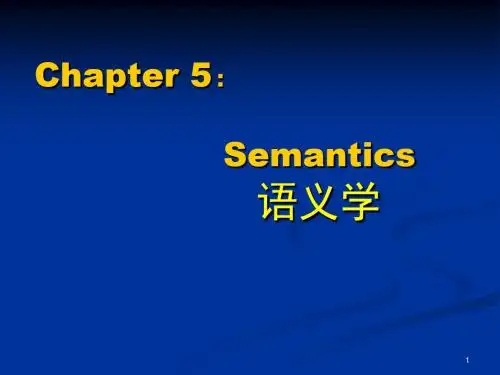
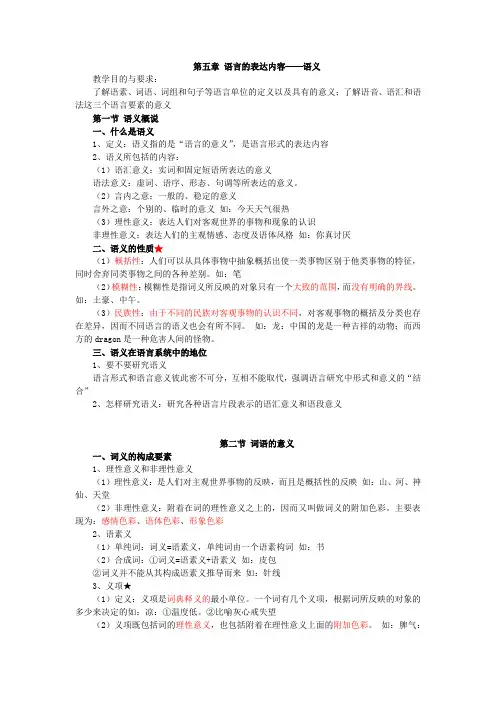
第五章语言的表达内容──语义教学目的与要求:了解语素、词语、词组和句子等语言单位的定义以及具有的意义;了解语音、语汇和语法这三个语言要素的意义第一节语义概说一、什么是语义1、定义:语义指的是“语言的意义”,是语言形式的表达内容2、语义所包括的内容:(1)语汇意义:实词和固定短语所表达的意义语法意义:虚词、语序、形态、句调等所表达的意义。
(2)言内之意:一般的、稳定的意义言外之意:个别的、临时的意义如:今天天气很热(3)理性意义:表达人们对客观世界的事物和现象的认识非理性意义:表达人们的主观情感、态度及语体风格如:你真讨厌二、语义的性质★(1)概括性:人们可以从具体事物中抽象概括出使一类事物区别于他类事物的特征,同时舍弃同类事物之间的各种差别。
如:笔(2)模糊性:模糊性是指词义所反映的对象只有一个大致的范围,而没有明确的界线。
如:土豪、中午。
(3)民族性:由于不同的民族对客观事物的认识不同,对客观事物的概括及分类也存在差异,因而不同语言的语义也会有所不同。
如:龙:中国的龙是一种吉祥的动物;而西方的dragon是一种危害人间的怪物。
三、语义在语言系统中的地位1、要不要研究语义语言形式和语言意义彼此密不可分,互相不能取代,强调语言研究中形式和意义的“结合”2、怎样研究语义:研究各种语言片段表示的语汇意义和语段意义第二节词语的意义一、词义的构成要素1、理性意义和非理性意义(1)理性意义:是人们对主观世界事物的反映,而且是概括性的反映如:山、河、神仙、天堂(2)非理性意义:附着在词的理性意义之上的,因而又叫做词义的附加色彩。
主要表现为:感情色彩、语体色彩、形象色彩2、语素义(1)单纯词:词义=语素义,单纯词由一个语素构词如:书(2)合成词:①词义=语素义+语素义如:皮包②词义并不能从其构成语素义推导而来如:针线3、义项★(1)定义:义项是词典释义的最小单位。
一个词有几个义项,根据词所反映的对象的多少来决定的如:凉:①温度低。



第一章:绪论1.什么是语言学?1.1定义语言学常被定义为是对语言进行系统科学研究的学科。
语言学研究的不是某一种特定的语言,而是人类所有的语言.为了揭示语言的本质,语言学家首先要对语言实际使用进行观察,并在此基础上形成有关语言使用的概括性假设,这些初步形成的假设要在语言使用中进行进一步的检验,最终形成一条语言理论。
1.2语言学的研究范畴:语言学研究有不同的侧重。
对语言体系作全面研究的语言学研究称为普通语言学.语音学主要是对语言声音媒介的研究,它不只是研究某一特定的语言的声音媒介,而是所有语言的声音媒介。
音系学与语音学不同,它主要研究特定语言的语音体系,即音是如何结合在一起产生有意义的单位。
形态学主要研究单词的内部语义结构,及这些叫做词素的语义最小单位是如何结合构成单词。
句法学主要研究构成潜在句子的句法规则.语义学以研究语义为目的,传统语义学主要研究抽象的意义,独立于语境之外的意义,语用学也是研究语义,但是它把语义研究置于语言使用语境中加以研究.语言不是一个孤立的现象,而是一种社会现象,各种社会因素都会对语言的使用产生影响。
从社会的角度来研究语言的科学被称之为社会语言学。
语言和社会之间的关系是社会语言学研究的主要内容.心理语言学主要从心理学的角度来研究语言.它要研究人们在使用语言时大脑的工作机理,如人是如何习得母语的,人的大脑是如何加工和记忆语言信息等问题。
把语言学的研究成果应用到实践中的科学形成了应用语言学。
狭义上,应用语言学指把语言理论和原则运用于语言教学的科学,在广义上,它指把语言理论与原则应用于解决实际问题的科学。
除此之外还有人类语言学、神经语言学、数学语言学、计算语言学等。
1.3语言学研究中的几对基本概念1.3.1规定性和描述性语言学研究是描述性的,不是规定性的。
这是语言学和传统语法的一个重要区别。
语言学研究的目的是对人们使用的语言进行客观描述与分析,而不是对语言的使用作出规定。
传统语法是规定性的,它主要建立在笔头语言基础之上,旨在规定一系列的语法规则,并且把这些语法规则强加给语言使用者。